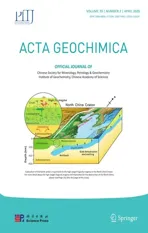Ecological risk assessment of surficial sediment by heavy metals from a submerged archaeology harbor,South Mediterranean Sea,Egypt
2020-05-06·
·
Abstract A protected semi-enclosed embayment, the Eastern Harbor(EH),is situated in the central sector of the Mediterranean coast of Alexandria, Egypt. It is a famous fishing dock and water-sport center and its importance arose after the discovery of the Ptolemaic royal quarter of ancient Alexandria. To protect this national treasure and improve its environmental health, the untreated anthropogenic effluents,which continued for decades into the EH since 1992, must be totally stopped. Accordingly, it is an important issue to continually monitor and asses the environmental status of the EH. The sediment texture, total organic carbon, and the accumulation, distribution, and ecological risks of Cd, Cr, Pb, As, Hg and Al were determined with a total of 14 surficial sediments samples collected in the EH during 2010. Metal contents were compared to the literature data to assess the pollution status of sediments.Enrichment factors,Degree of contamination(mCd) and potential ecological risk were calculated as a criterion of possible contamination. Since mCd calculation produces an overall average value for a range of pollutants,in the present study the contamination factor that provides a measure of the degree of overall contamination in the surface layers in a particular sampling site may provide a better indication of the state of pollution in the EH sediments than other indicators.
Keywords Heavy metals · Eastern harbor · Enrichment factors·Degree of contamination·Potential ecological risk
1 Introduction
Alexandria is the largest city on the Mediterranean coastline of Egypt. It is the main commercial harbor, industrial center and summer resort with a population of nearly 6.5 million inhabitants.Alexandria was one of the main centers of Hellenistic civilization. It is celebrated for its unique blend of Ancient Egyptian, Greek, Roman and Islamic cultures. The eventful history of the city’s history has resulted in a variety of archaeological relics,which remain.This is due to the fact that the coastal region, where Alexandria is situated in,has subsided since ancient times.The straight coastline of Alexandria extends to about 80 km with slight undulations forming small embayments(El-Wakeel and El-Sayed 1978).One of these embayments was artificially transformed into the Eastern Harbor (EH).The Harbor has a surface area of about 2.53 km2.Accordingly,its volume is about 15.2 × 106m3(Abdallah 2007). The harbor is also one of the fishing docks and acts as an important water-sporting center in Alexandria city.The importance of the harbor was boosted after the excavations of a historic site at the foot of Qait Bey Fort,which discovered thousands of submerged archaeological artifacts and part of the Ptolemaic royal quarter that represents a significant era of ancient Alexandria (Goddio 1998). To protect and conserve this historical human heritage, it was proposed to implement an under-water museum in part of the EH,yet the Harbor environmental health could limit the success of this project.
The marine environment of the EH experienced about 25 years of receiving a considerable amount (20,000 m3/day)of untreated sewage flow that was discharged directly through several marine submerged minor sewage out falls distributed along the Eastern Harbor coast or indirectly from Qait Bey Sewage pumping station through El-Boughaz inlet (Abdallah 2017). Most of these outfalls were originally made to serve as disposal sites only for storm(rainy) waters of the seaside (Cornish) street during the rainy season (in winter) as a fast solution to protect Alexandria’s coast from drowning in the storm water. In addition to raw sewage,the pollutants in the harbor include wastes from various small industries such as: photo development shops, car cleaning and repairing, foodstuff plants, gas stations, small dairy plants and foundries (Abdallah 2007, 2017). Currently, the EH receives anthropogenic wastes from anchored fishing boats and the shipyard situated at its western part. Beside these, and due to local water circulation,the Harbor occasionally receives an additional amount of untreated sewage wastes through its two openings from two marine outfalls,one of them lies at Qait Bey Outfall with a discharge rate about 150 × 103m3/d and the other at El-Silsila Outfall with a discharge rate about 50 × 103m3/d (El-Rayis and Hinckely 1999).Additionally,a continuous risk from the existing oil and fuel related activities (fishing boats, bunkering…etc.)is present.Therefore,the Harbor sediments were highly affected by anthropogenic inputs and progressively undergone several changes in character (Abdallah and Mohamed 2015). These effluents had led to a considerable increase in the level of nutrients and trace metals in the Harbor waters and sediments (Abdallah 2007; Kremling and Petersen 1981). It was believed that the best way to protect these sites was to stop the discharges from landbased sources so that sewage outfalls inside the EH were partially closed since 1993. This work is one of many studies that aim to continuously monitor and assess the environmental conditions in the EH. The objectives of the present work are to illustrate the distribution of trace metals in the surficial sediments and their assessment by sediment quality guideline as indicators to identify the present degree of sediment contamination, to assess the potential ecological risk of contamination and to predict sediment toxicity in the EH.
2 Materials and methods
2.1 Sampling
A total of 14 surface sediment samples (0–5 cm) were collected. The samples represented the whole area of the Eastern Harbor(EH)during March 2010(Fig. 1).Samples were collected with a van Veen grab sampler and the upper 3–5 cm of sediment was removed with a PTFE spatula.The samples were taken with a polyethylene spoon to avoid contamination by the metallic parts of the sampler. Samples were then stored in plastic cups that were cleaned by 1:1 HCl and 1:1 HNO3and were stored refrigerated at 4 °C until analysis (American Society for Testing and Materials(ASTM) 1991).
2.2 Textural and geochemical analyses
In the laboratory, samples were dried in an oven at 50 °C for 3–4 days. Later, they were lightly ground in an agate mortar for homogenization, sieved to pass <63 mm(Morillo et al 2004) and prepared for analysis. Laser technique for grain size analysis was performed using SALD 3100 (Shimadzu-laser analyzer). The inclusive graphic mean size(Mz Φ)was calculated according to Folk and Ward (1957) in addition to the percentages of sand(S%), silt (Z%) and clay (C%). Loss-on-ignition procedures were applied for total carbon and total inorganic carbon determination using TOC-SSM-5000 a solid sample module,TOC-V CSH/CSN(Shimadzu-total organic carbon analyzer)at 980 °C and 200 °C,respectively.Total organic carbon (TOC%) was calculated as the difference of total carbon and total inorganic carbon measurements.
For heavy metal analysis, the dried and powdered sediments were digested in a mixture of HF-HClO4-HNO3(Loring and Rantala 1992) and brought into solution in 0.5 M HCl (25 ml) using deionized double distilled water(DDDW). All chemicals were supplied by MERK and Prolabo Central Drug House (P) Ltd. Samples were analyzed using an ICP Mass Spectrometer (ELAN DRC-e,Axial Field Technology, Perkin Elmer Sciex). Ultrapure distilled water was used in all procedures of heavy metals determination. The reagent blanks were included in each batch of analysis and monitored throughout the analysis and they were used to correct the analytical results. All absorbance readings were made in triplicates. Calibration standard runs were regularly performed to evaluate the accuracy of the analytical method. The accuracy of the analytical procedure was checked using a triplicate analysis of the certified reference materials. The accuracy of the analytical procedure was checked using a triplicate analysis of certified reference material(MESS-3)from the National Research Council of Canada (Table 1).
2.2.1 Degree of contamination (mCd)
According to the following equation that is proposed by Hakanson (1980) based on the calculation for each pollutant of a contamination factor (Cf):

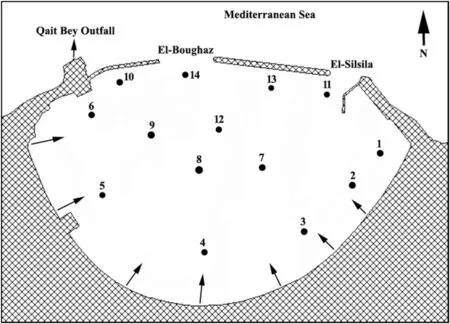
Fig. 1 Sampling location in the Eastern Harbor

Table 1 Metal extracted from standard reference material MESS-3 (n= 3)
where, C0and Cnrefer to the mean concentration of a heavy metal in the contaminated sediments and the preindustrial ‘‘baseline’’ sediments, respectively. Hakanson’s equation was used to calculate the modified degree of contamination(mCd)for the five studied elements(Cd,Pb,Cr, As and Hg). This modified method can therefore provide an integrated assessment of the overall enrichment and impact of contamination of pollutant groups in sediments.
The modified equation for a generalized approach to calculating the degree of contamination is given as:

where,n is the number of analyzed heavy metals and Cifis the contamination factor.
2.2.2 Potential ecological risk (PER)
The degree of heavy metal pollution in surface sediments of the EH was assessed by calculating the Toxic Response Factor(TRF),which depends on the sedimentological toxic factor (STF) and the sedimentological sensitivity factor(SSF). STF includes the toxicity variable, assigned by Hakanson et al. (2003), which reflects the different toxic effects of each metal in natural aquatic systems. The following metals were classified in decreasing order of toxicity:

Generally,the negative effect of metals tends to increase with a decrease of the bio-production. For SSF estimation,the bio-production ratio (BPR) was calculated. The best responses were found using the ratio among total phosphorous and TOC%.Therefore,BPR was calculated as follows:

The Toxic Response Factor(TRF)is calculated for each metal as follows:

Thus, the potential ecological risk for each metal was calculated according to the equation:PER=TRF×Cf
3 Results and discussion
3.1 Texture and organic carbon
The mean grain size(MzΦ)and TOC%distribution in the bottom sediments of the EH are given in Table 2. The average grain size varied from - 1.13 to 3.43 Φ with an average of 0.81 Φ. The results reveal wide variation in textural composition observed in the EH sediments and predominantly composed of sand silt clay at the majority of the locations. The texture of the EH sediments were dominated by coarse grained fractions (>64%) covering the north west and south west areas, whereas the harbor region contained medium grained fraction (>21%) to clayey-silt (>14%). The variation of the grain size couldbe attributed to the bottom configuration and the current regime within the Harbor where the fine fractions were deposited in the depression and the coarse fraction were deposited on the nearly flat bottom.
And outside the house was a large courtyard with horse and cow stables and a coach-house--all fine buildings; and a splendid garden with most beautiful flowers and fruit, and in a park quite a league long were deer and roe10 and hares, and everything one could wish for
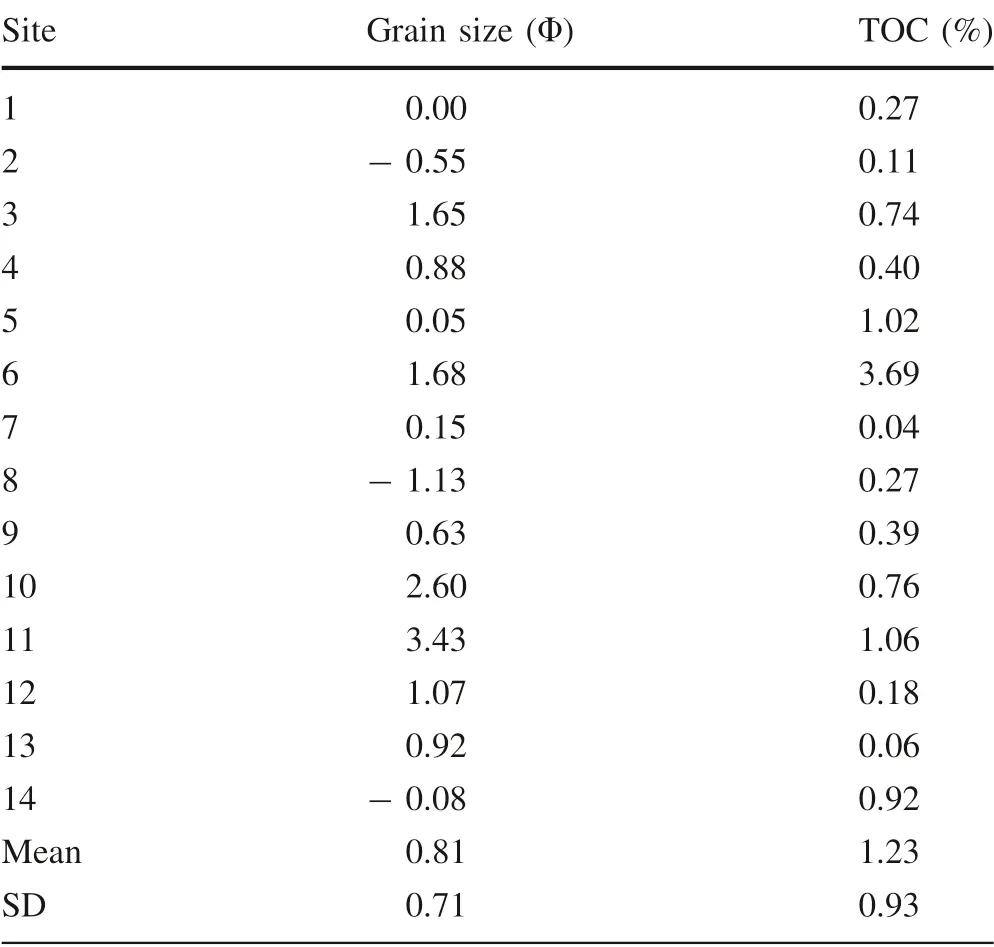
Table 2 Mean grain size and TOC% of studied metals in surface sediments from the Eastern Harbour
Total organic carbon(TOC)is one of the most important indicators of pollutants in marine sediments, and it gives a clear idea about the source of runoff in any particular area.TOC ranged from 0.04% to 3.69% with an average of 0.71%. The average organic carbon content, in the present study,were generally lower than those recorded previously in the EH.The TOC has had a steady decrease in level with time probably due to closure of the outlets of the untreated discharged domestic waste in the EH since 1993.TOC had a moderate positive correlation with grain size (r2= 0.47,p <0.001), indicating that grain sizes control TOC distribution to a certain extent in the EH surface sediments.There is a general tendency for the finer sediment to have high contents of TOC. Fine to very fine-grained sediments tend to have relatively high TOC due to the high specific surface area of the smaller particles (Horowitz and Elrick 1987). However, this fact is not clearly evident in the present study because of the contamination of the coarser sediments covering most of the EH with the allochthonous organic matter from different land-based sources.
3.2 Elemental concentrations
The trace elements concentrations in the EH surficial sediments are given in Table 3 and illustrated as contour maps in Fig. 2.Since the sediments from different stations of the EH are originated from the same environmental sources,these sediments should have a similar texture and elemental composition type. Recently, the sediments in the EH are influenced and stressed by natural and anthropogenic pressure (Alves et al. 2016). The most abundant element in the EH sediments was Al at average concentrations >2160 μg/g. Pb and As follows Al in abundance and have with average 81.1 and 78.2 μg/g. Low average concentration (9.9 μ/g) was observed for Cr. Lower concentrations were recorded for Cd and Hg (1.33 and 0.59 μg/g), respectively (Table 3). The mean concentrations of elements are comparable to those in other impacted Harbors elsewhere(Table 4).Aluminum typically displays a uniform distribution and largely different from pollutionderived elements (Fig. 2). This is expected, since soil-related elements such as Al exist in the alumino-silicate matrix of sediments (Chen et al 2007; Kumar et al. 2001).Significant correlation between Al concentrations and MzΦ was observed (r2= 0.62, p <0.001), indicating that Al concentrations are mainly controlled by the grain size as a result of natural weathering processes.
The remaining studied elements (As, Cr, Cd, Pb, Hg)have exhibited similar patterns with maximalconcentrations found in sediments near the shipyard (site No.6),suggesting common sources or similar geochemical behavior of these elements (Fig. 2). This could be related to three factors:(1)high concentration of urban wastes;(2)prevailing anticlockwise marine currents; and (3) several outfalls located in the EH southern margin (Fig. 1).Unfortunately,concentrations of these elements are used as markers or tracers of metal industries (Kumar et al. 2001;Gallego et al. 2002; Loska et al 2004).
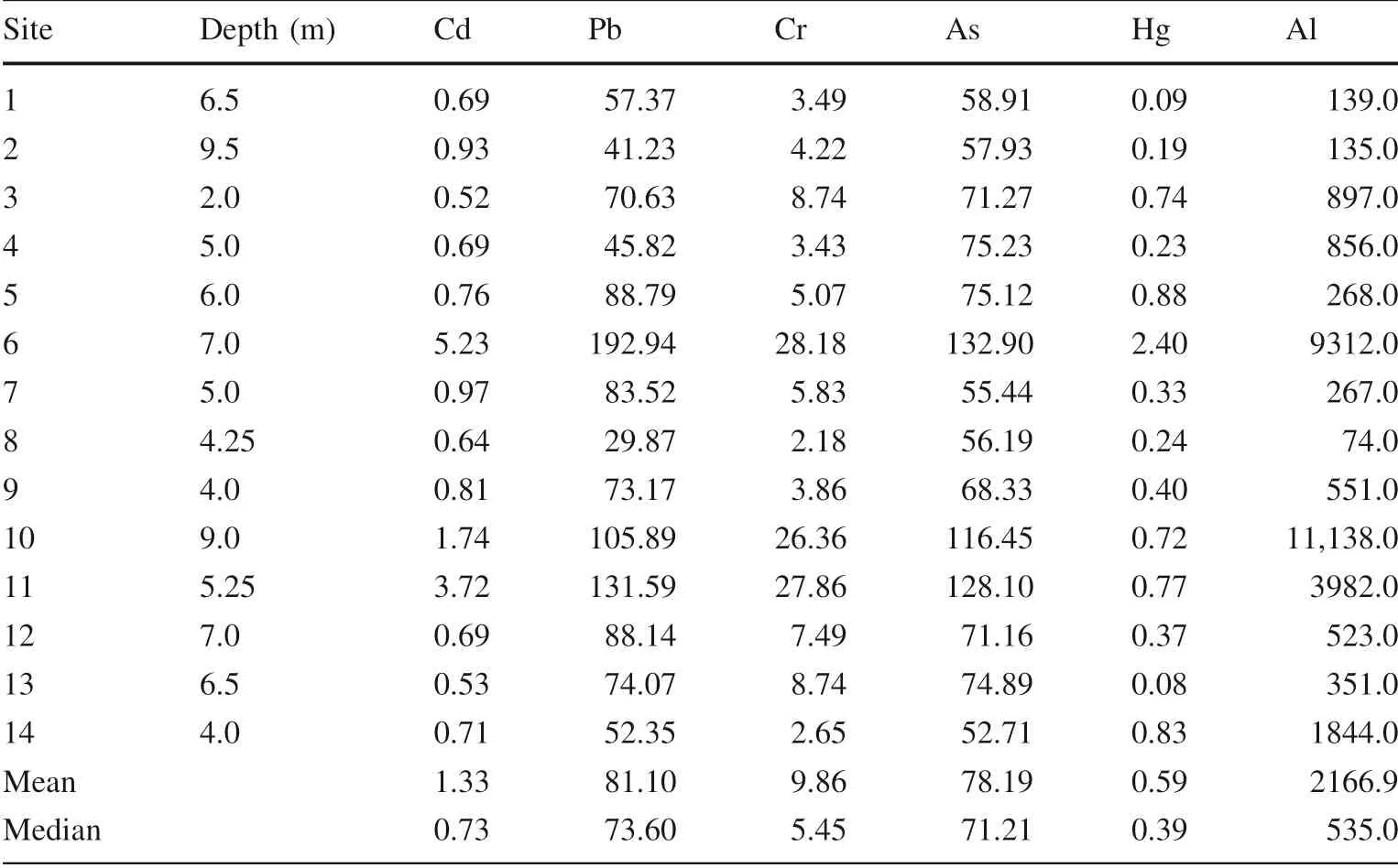
Table 3 Metals concentrations(μg/g dry weight) and depth(m) in sediment samples
The grain size is a major factor controlling natural concentrations of trace metals in sediments (Zhang et al.2001; Abdallah 2014). The fine sediments tend to have relatively high metal contents, due to the high specific surface of the finer particles. This is evidenced by the strong correlation between grain size and trace elements concentration (r >0.73). This confirms that the high dependence and affinity of the studied trace elements for fine sediments. Also, coatings of organic matter are prevalent in fine sediments (r >0.75), and these coatings bind a variety of trace elements. The heavy metals are enriched in clay and organic matter by precipitation as metallic coatings,incorporation in crystalline structure and adsorption on cation exchange sites (Armstrong et al.1976). This might explain the significant correlation recorded between trace metals with TOC and MzΦ in the EH.Fine sediments with high organic matter content retain more contaminants than does relatively coarse sandy sediment (De Mora et al. 2004).
3.3 Evaluation of pollution status in the EH
Two processes are usually used for assessing the pollution status of sediments:(1)comparison of metal concentrations in sediments with those of background concentrations expressed as enrichment factors (EF) and, (2) comparison with sediment quality guidelines for each contaminant and the cumulative effects of contaminants in sediments.
3.3.1 Enrichment factors (EF)
To assess anthropogenic pollution in sediments and soils,geochemical normalization processes are usually used(C¸elik et al. 2009; Esen et al. 2010). Due to the different magnitude of source contributions at each site in the EH,the chemical composition of sediments may be different at each sampling site. Generally, an enrichment factor (EF)technique is a good tool to differentiate between anthropogenic and naturally occurring sources of metals and is used to determine the degree of modification in the composition. The enrichment factors we calculated for all analyzed metals in this study are given in Fig. 3. Since Cr in this studied area has an enrichment factor that is less than 10, it is considered without enrichment (Zahra et al 2014). This indicates that Cr in the studied sediment is originated predominantly from lithogenous material.About 57,50,14 and 71%of Cd,Pb,As and Hg were in the group‘‘medium enrichment’’ (10 <EF <100) with increasing median factors of enrichment.The most enriched elements(EF >100)are 43,50,86 and 29%of Cd,Pb,As,and Hg,respectively.
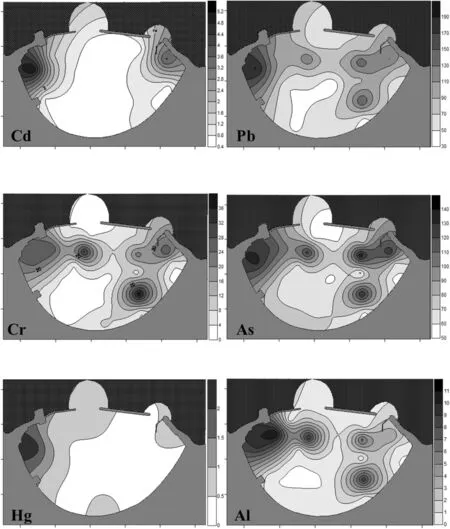
Fig. 2 Spatial distribution of Cd, Pb, Cr, As, Hg and Al (mg/g) in surface sediments of the Eastern Harbor
the sediments in the vicinity of small sewers which carry mixed waste discharge from nearby small industries and domestic sewage as well as in the vicinity of shipyards and the anchorage of fishing boats,Cd and Pb are known as the markers of paint industries (Lin et al. 2002). However, Cr having enrichment factors less than 10, for all sites; fall in the group of elements without enrichment in the study area.According to Calmano et al. (1990), the difference in EF values for the different studied metals in the harbor sediments may be due to the difference in the magnitude of input for each metal in the sediment and/or the difference in the removal rate of each metal from the sediment.When observing changes in conditions as pH, redox potential,ionic strength and the concentration of organic complexing agents, the metals can be released with the water phase.

Table 4 Average metal concentrations (μg/g) in sediments from different regions of the world
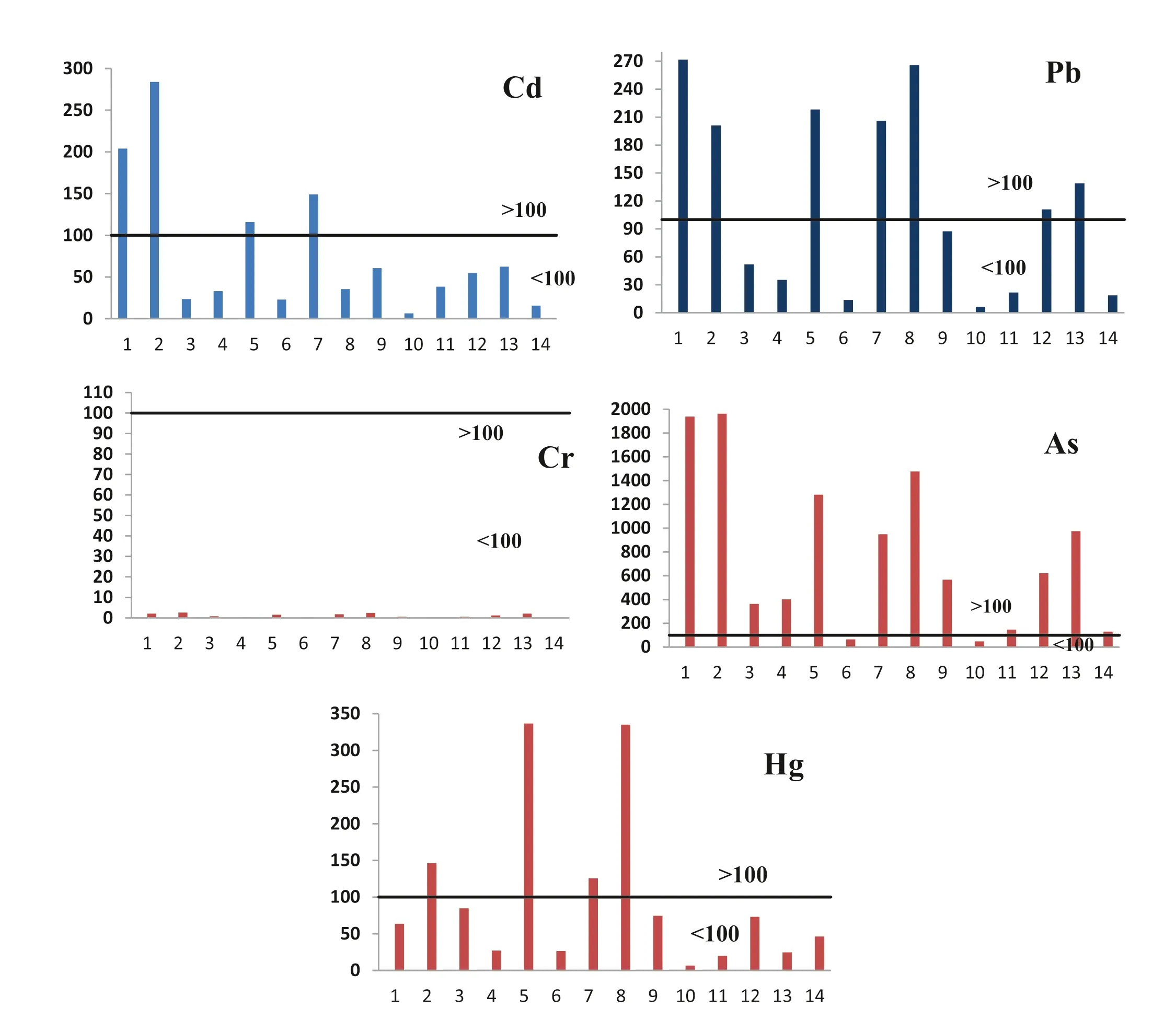
Fig. 3 The mean enrichment value of studied metal in surface sediments of the EH
3.3.2 Degree of contamination (mCd)
For the classification and description of the mCdaccording to Abrahim and Parker (2008), about 86% of the studied sediments were in the range (8 ≤mCd<16) representing a very high degree of contamination. The contamination apparently comes from sewers that include industrial wastes in addition to the outside source. The low movement of sediments also contributed to the contamination.Extremely high degree of contamination(16 ≤mCd<32)were observed in about 14% of the EH sediments (at stations 10 and 11as shown in Fig. 4),which are located near the shipyards and the outside source of the harbor and its outlet. Moreover, the ultra-high degree of contamination(mCd≥32) was recorded in the sediment of station number 6 which lies in the vicinity of shipyards and the anchorage of fishing boats, which indicates very serious anthropogenic pollution at this site (Fig. 4).
3.3.3 Assessment of potential ecological risk (PER)

Fig. 4 Degree of contamination in each site of the EH sediments
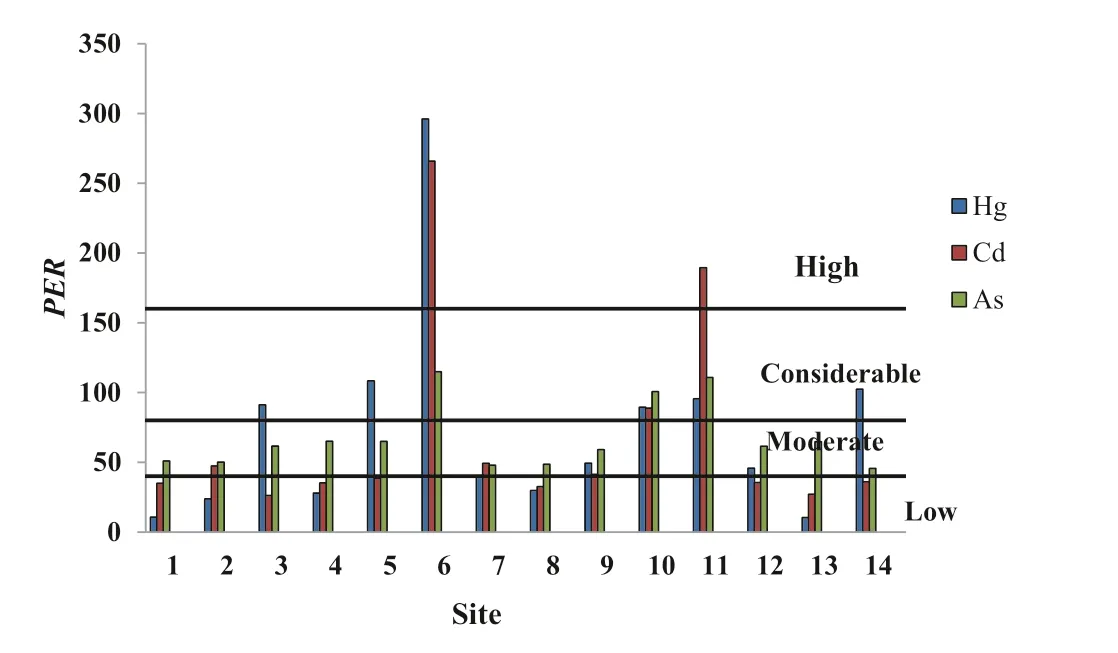
Fig. 5 Potential Ecological Risk (PER) of Hg, Cd and As in the EH sediments
Higher relative participation of Hg, Cd and As PER was found for the EH. The harbor is considered a receptor of industrial effluents. However, it receives significant amounts of mixed wastes. There is a possibility of transference of metal contamination from external source through the El Boghaze opening. Hence, the responsible substances for sedimentological sensitivity factor (OM,TP) and the considered metals have the same source or interdependent sources such as domestic wastes without treatment and wastes from shipyard installation. The contaminant bioavailability is reduced when there is an increase in sediment anoxia and trophic state of water column.
According to Hakanson et al. (2003), the sedimentological sensitivity factor (SSF) is related to the trophic status of the system,which influences the bioavailability of metals. The EH was found to be a meso-to eutrophic bay,this is usual for a confined inshore area, but it was not as eutrophic as a polluted neighboring bay (El Mex Bay),which receives huge amounts of agricultural drainage waters contaminated by sewage at a rate of 6 million m3/day(El-Rayis and Abdallah 2006).In eutrophic aquatic eco-systems, metals are less bioavailable due to complexation effects and to biological dilution (Hakanson et al.2003).
About 43, 21 and 14% of the EH sediment has considerable potential ecological risk for Hg, As, and Cd respectively,in the same context as the high PER represent 14% of Cd and 7% for Hg in the harbor sediment (Fig. 5).It is reasonable to envisage that Hg and Cd are the two major ecological risks in the EH sediments.
4 Conclusion
The Eastern Harbor(EH)is one of the most popular tourist site and fishing location in Alexandria City, Egypt. Identifying the degree of sediment contamination and assessing the potential ecological risk of contamination is necessary in order to assess the overall level of pollution.This project studied the fine fraction of surficial sediments from 14 sites. The impact of anthropogenic heavy metal pollution on EH was evaluated using Enrichment Factors (EF), as well as modified degrees of contamination (mCd), and the potential ecological risk (PER) for Cd, Cr, Pb, As and Hg.Normalized enrichment factor(EF)values for heavy metals were calculated for EH using the continental shale abundance of Al. The results show that high average EF values for Cd,Pb,As and Hg.The differences in EF values for the studied metals may be due to the differences in inputs of each metal to the sediments and/or the differences in the removal rates of each metal from the sediments. For the classification and description of the mCd,about 86%of the studied sediments represent very high degrees of contamination, which apparently come from sewers that include industrial wastes. Additionally, extremely high degree of contamination were observed near the shipyards and the outside source of the harbor and its outlet. On the other hand, the ultra-high degree of contamination was recorded in the vicinity of shipyards and the anchorage of fishing boats,which indicates very serious anthropogenic pollution at this site.About 43%,21%,and 14%of the EH sediments have considerable potential ecological risks with Hg, As and Cd, respectively. In the same context, the high PER represent 14% of Cd and 7% for Hg in the harbor sediments. It is reasonable to envisage that Hg and Cd are the two main ecological risks in the EH sediments.
AcknowledgementsThis study was accomplished as a part of a fully-funded Grant of Matsumae International Foundation,Japan.We would like to express our deepest thanks for Prof. Dr. Kimihiko Oki and Prof.Dr.Takashi Tomiyasu for providing much help and advice.We wish to thank all members of the Kagoshima University Museum and Department of Earth and Environmental Sciences, Faculty of Science, Kagoshima University for their help and support.
杂志排行
Acta Geochimica的其它文章
- High oxygen fugacity magma: implication for the destruction of the North China Craton
- The effect of pH on the sorption of gold nanoparticles on illite
- Methane production from rice straw carbon in five different methanogenic rice soils: rates, quantities and microbial communities
- Optimizing the ratio of the spike to sample for isotope dilution analysis: a case study with selenium isotopes
- Antimony removal from wastewater by sulfate-reducing bacteria in a bench-scale upflow anaerobic packed-bed reactor
- Discrimination geochemical interaction effects on mineralization at the polymetallic Glojeh deposit, NW Iran by interative backward quadratic modeling
